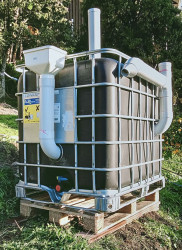



Besides Methane other gasses are produced too like CO2 and H2S (Hydrogen sulphide) which stinks like rotten eggs but our filter systems remove this smelly gas before it reaches your cooker. Methane (CH4) does not smell at all and is not dangerous because none of the gas is under pressure and as soon as it is mixed with air it becomes completely non-volatile.
The stove takes oxygen from the air at the flame, not before it like LPG does. We use a small gas pump of 20W, plugged into a 230V power outlet near your stove. If you don't have 230V power then you can use sand bags or other weight placed on the gas bag to push the gas through the gas line.